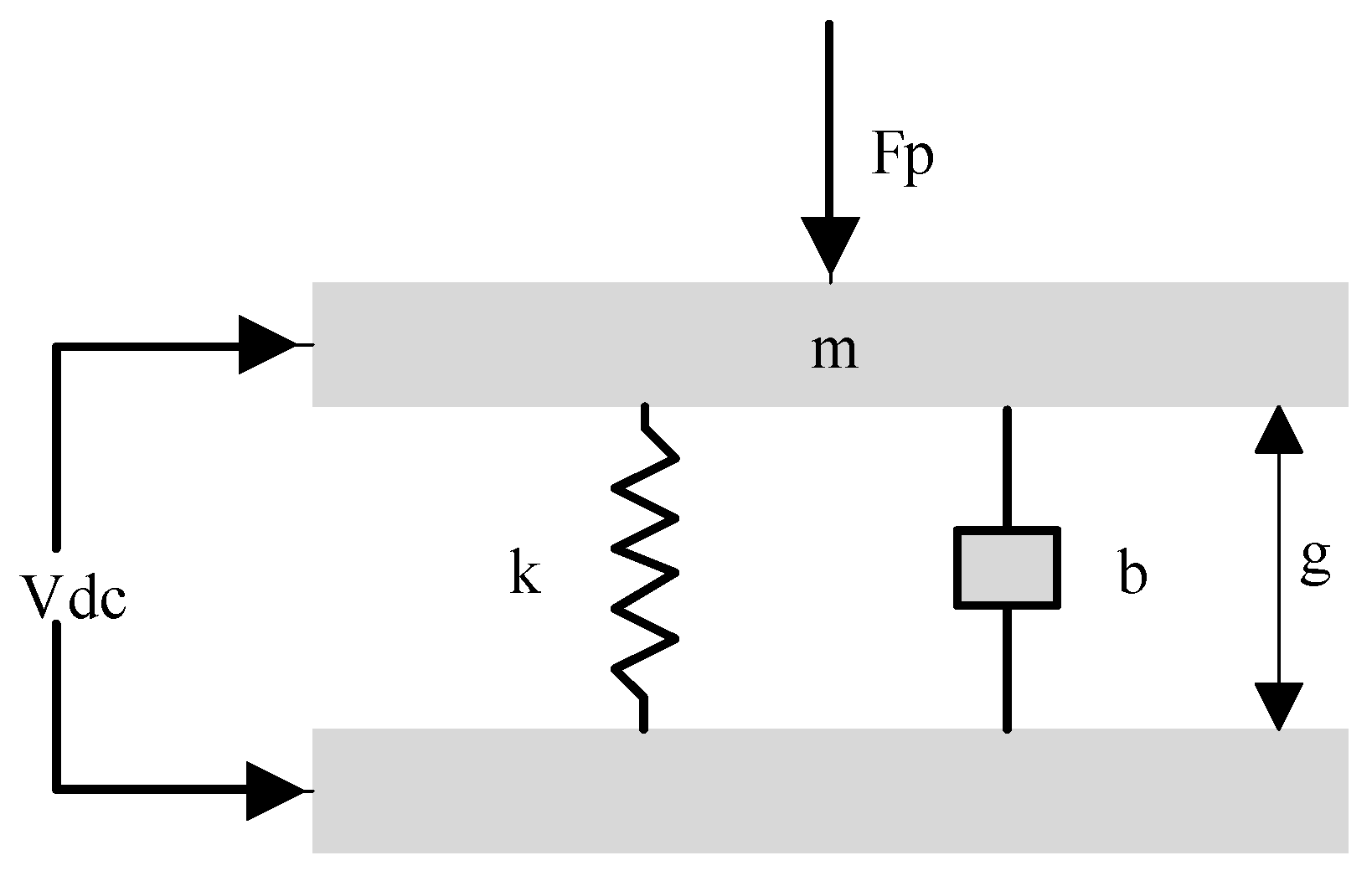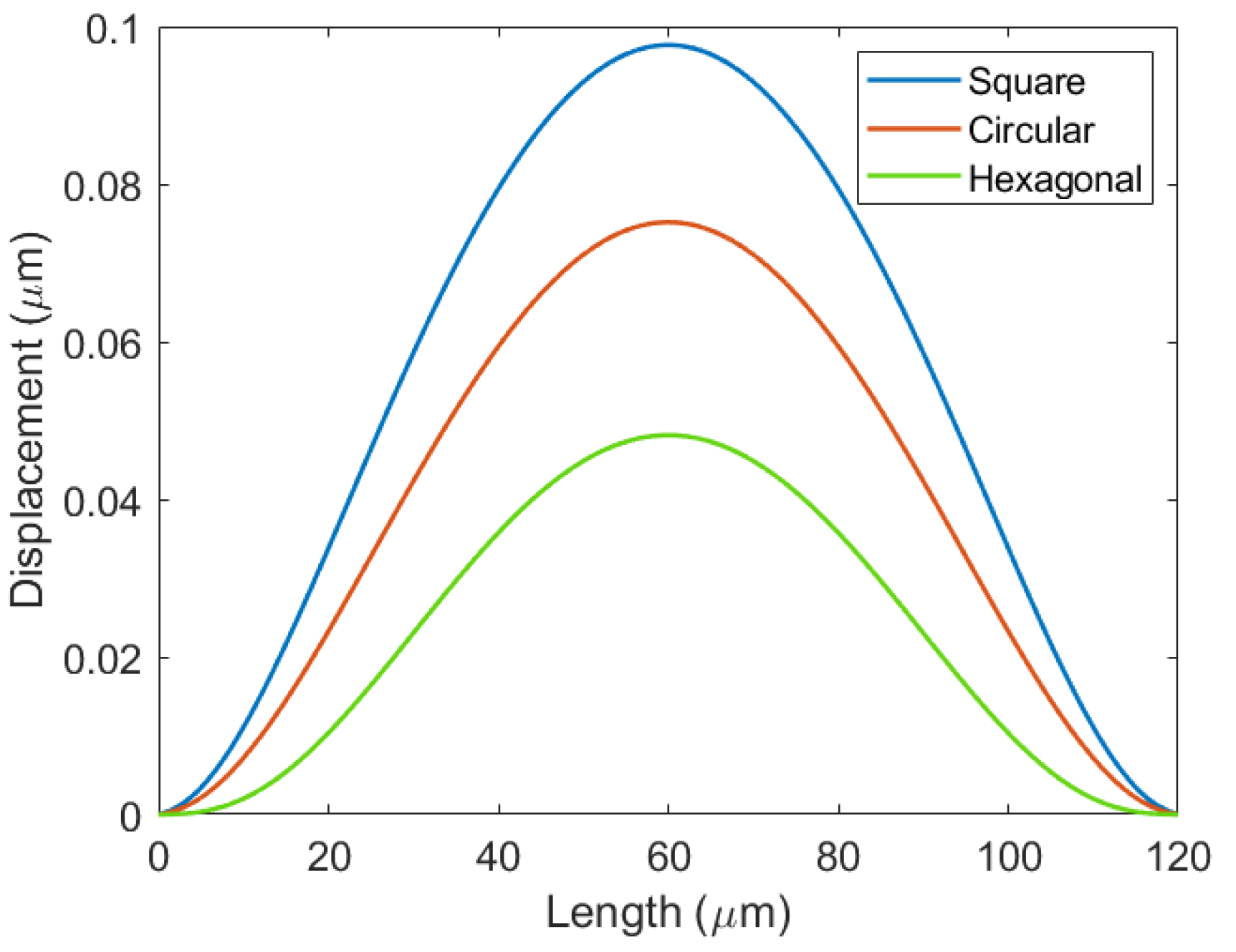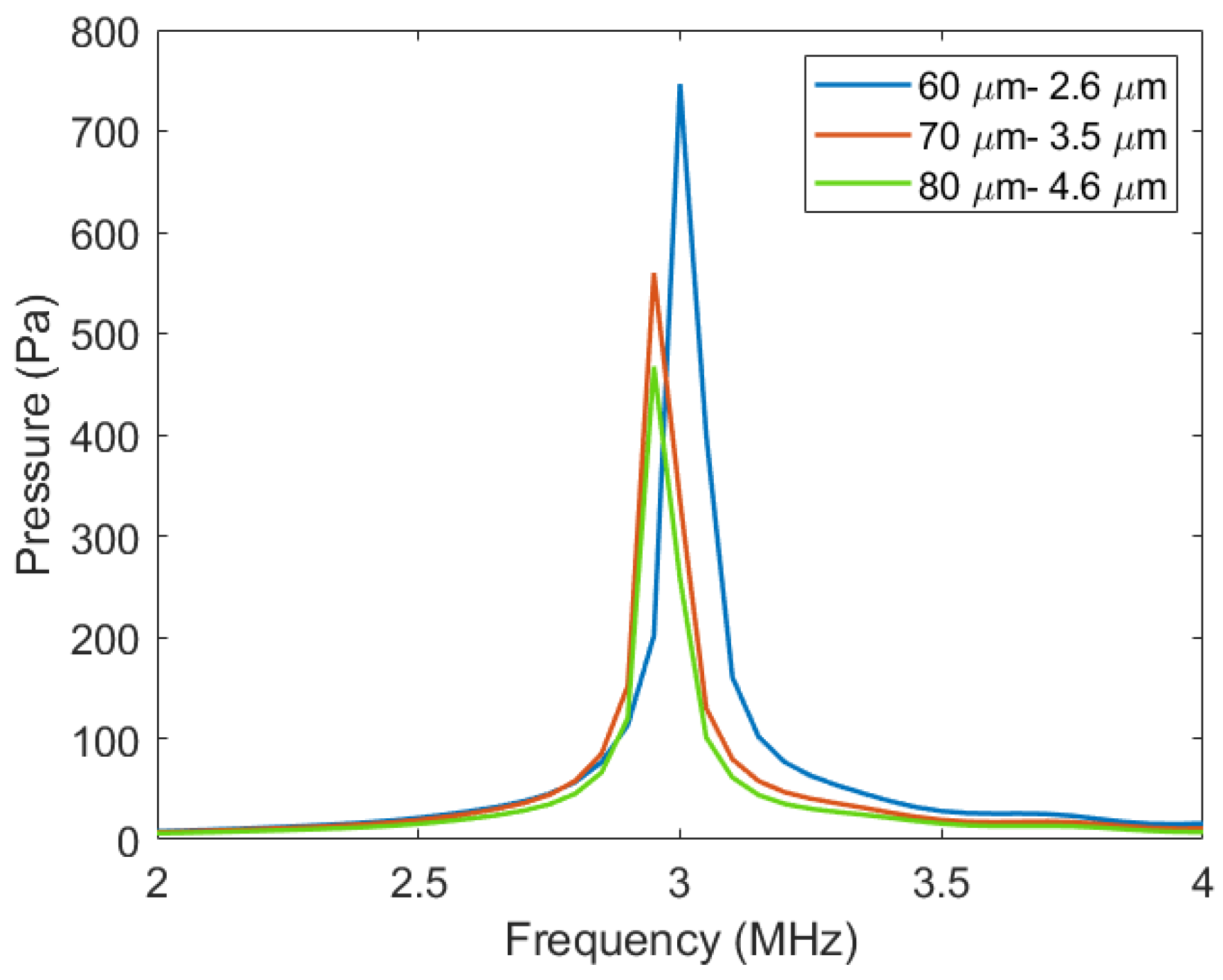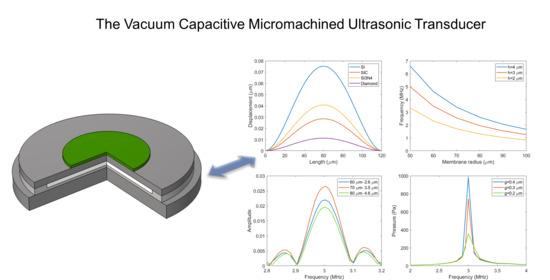Investigation on Design Theory and Performance Analysis of Vacuum Capacitive Micromachined Ultrasonic Transducer
Abstract
:1. Introduction
2. Theoretical Analysis of Vacuum CMUT
2.1. Vacuum CMUT Cell Structure
2.2. Vacuum CMUT Design Principle
2.2.1. Frequency
2.2.2. Membrane Deflection
2.2.3. Transmission Sound Pressure
2.2.4. Reception Sensitivity
2.2.5. Fractional Bandwidth
3. Finite Element Analysis of Vacuum CMUT
3.1. The Influence of Membrane Materials on the Deflection of Vacuum CMUT Cell
3.2. The Influence of Membrane Shape on Deflection of Vacuum CMUT Cell
3.3. The Influence of Membrane Radius Thickness on the Performance of VACUUM CMUT
3.4. The influence of Cavity Height on the Performance of Vacuum CMUT
4. Conclusions
Author Contributions
Funding
Data Availability Statement
Conflicts of Interest
References
- Oralkan, O.; Ergun, A.S.; Johnson, J.A.; Karaman, M.; Demirci, U.; Kaviani, K.; Lee, T.H.; Khuri-Yakub, B.T. Capacitive micromachined ultrasonic transducers: Next-generation arrays for acoustic imaging? IEEE Trans. Ultrason. Ferroelectr. Freq. Control 2002, 49, 1596–1610. [Google Scholar] [CrossRef]
- Fouan, D.; Bouakaz, A. Investigation of Classical Pulse Sequences for Contrast-Enhanced Ultrasound Imaging With a cMUT Probe. IEEE Trans. Ultrason. Ferroelectr. Freq. Control 2016, 63, 1496–1504. [Google Scholar] [CrossRef] [PubMed]
- Sautto, M.; Savoia, A.S.; Quaglia, F.; Caliano, G.; Mazzanti, A. A Comparative Analysis of CMUT Receiving Architectures for the Design Optimization of Integrated Transceiver Front Ends. IEEE Trans. Ultrason. Ferroelectr. Freq. Control 2017, 64, 826–838. [Google Scholar] [CrossRef] [PubMed]
- Greenlay, B.A.; Zemp, R.J. Fabrication of Linear Array and Top-Orthogonal-to-Bottom Electrode CMUT Arrays With a Sacrificial Release Process. IEEE Trans. Ultrason. Ferroelectr. Freq. Control 2017, 64, 93–107. [Google Scholar] [CrossRef]
- Wang, H.L.; Wang, X.J.; He, C.D.; Xue, C.Y. Design and Performance Analysis of Capacitive Micromachined Ultrasonic Transducer Linear Array. Micromachines 2014, 5, 420–431. [Google Scholar] [CrossRef] [Green Version]
- Wang, H.L.; Wang, X.J.; He, C.D.; Xue, C.Y. Directivity Theory and Analysis of 2D Capacitive Micro-Machined Ultrasonic Transducer Array. J. Nanoelectron. Optoelectron. 2017, 12, 786–794. [Google Scholar] [CrossRef]
- Wang, H.L.; Lv, Y.F.; Wang, C.J.; Wang, X.; He, C.D.; Xue, C.Y.; He, S. Simulation Analysis and Performance Testing Investigation of Capacitive Micromachined Ultrasonic Transducer. Int. J. Pattern. Recogn. 2018, 32. [Google Scholar] [CrossRef]
- Wang, H.L.; Wang, X.J.; He, C.D.; Xue, C.Y. Investigation and analysis of the influence of excitation signal on radiation characteristics of capacitive micromachined ultrasonic transducer. Microsyst. Technol. 2018, 24, 2999–3018. [Google Scholar] [CrossRef] [Green Version]
- Wang, H.L.; Tong, Y.F.; Wang, X.J.; He, C.D.; Xue, C.Y. Experimental investigation of the influence of excitation signal on radiation characteristics of capacitive micromachined ultrasonic transducer. Microsyst. Technol. 2018, 24, 5055–5063. [Google Scholar] [CrossRef]
- Koymen, H.; Senlik, M.N.; Atalar, A.; Olcum, S. Parametric linear modeling of circular cMUT membranes in vacuum. IEEE Trans. Ultrason. Ferroelectr. Freq. Control 2007, 54, 1229–1239. [Google Scholar] [CrossRef]
- Degertekin, F.L.; Guldiken, R.O.; Karaman, M. Annular-ring CMUT arrays for forward-looking IVUS: Transducer characterization and imaging. IEEE Trans. Ultrason. Ferroelectr. Freq. Control 2006, 53, 474–482. [Google Scholar] [CrossRef]
- Wu, X.; Sanders, J.L.; Zhang, X.; Yamaner, F.Y.; Oralkan, O. An FPGA-Based Backend System for Intravascular Photoacoustic and Ultrasound Imaging. IEEE Trans. Ultrason. Ferroelectr. Freq. Control 2019, 66, 45–56. [Google Scholar] [CrossRef]
- Legros, M.; Novell, A.; Bouakaz, A.; Ferin, G.; Dufait, R.; Certon, D. Tissue Harmonic Imaging with CMUTs. In Proceedings of the 2011 IEEE International Ultrasonics Symposium, Orlando, FL, USA, 18–21 October 2011; pp. 2249–2252. [Google Scholar]
- Wong, S.H.; Kupnik, M.; Buts-Pauly, K.; Khuri-Yakub, B.T. P1B-10 Advantages of Capacitive Micromachined Ultrasonics Transducers (Cmuts) for High Intensity Focused Ultrasound (HIFU). In Proceedings of the 2007 IEEE Ultrasonics Symposium, New York, NY, USA, 28–21 October 2007; pp. 1313–1316. [Google Scholar]
- Wang, C.; Stevenson, T.; Vickers, W.; Comyn, T.P. Wedge design for high-temperature ultrasonic flow rate measurement. Sens. Actuators A Phys. 2019, 298, 111585. [Google Scholar] [CrossRef]
- Satir, S.; Zahorian, J.; Degertekin, F.L. A large-signal model for CMUT arrays with arbitrary membrane geometry operating in non-collapsed mode. IEEE Trans. Ultrason. Ferroelectr. Freq. Control 2013, 60, 2426–2439. [Google Scholar] [CrossRef] [PubMed] [Green Version]
- Maadi, M.; Zemp, R.J. A nonlinear lumped equivalent circuit model for a single uncollapsed square CMUT cell. IEEE Trans. Ultrason. Ferroelectr. Freq. Control 2019, 66, 1340–1351. [Google Scholar] [CrossRef] [PubMed]
- Lohfink, A.; Eccardt, P.-C. Linear and nonlinear equivalent circuit modeling of CMUTs. IEEE Trans. Ultrason. Ferroelectr. Freq. Control 2005, 52, 2163–2172. [Google Scholar] [CrossRef] [PubMed]
- Yaralioglu, G.G.; Ergun, S.; Khuri-Yakub, B.T. Finite-element analysis of capacitive micromachined ultrasonic transducers. IEEE Trans. Ultrason. Ferroelectr. Freq. Control 2005, 52, 2185–2198. [Google Scholar] [CrossRef]
- Wang, H.; Wang, X.; He, C.; Xue, C. Reception characteristics investigation and measurement of capacitive micromachined ultrasonic transducer. Sens. Rev. 2019, 40, 237–246. [Google Scholar] [CrossRef]
- 21. Zhao Xiaonan. Study on Air-coupled Capacitive Micromachined Ultrasonic Transducers. Master’s Thesis, Tianjin University, Tianjin, China, 2017. (In Chinese).
- Mølgaard, M.J.; Hansen, J.M.; Jakobsen, M.H.; Thomsen, E.V. Sensitivity optimization of wafer bonded gravimetric CMUT sensors. J. Microelectromechanical Syst. 2018, 27, 1089–1096. [Google Scholar] [CrossRef] [Green Version]
- Yamaner, F.Y.; Zhang, X.; Oralkan, Ö. A three-mask process for fabricating vacuum-sealed capacitive micromachined ultrasonic transducers using anodic bonding. IEEE Trans. Ultrason. Ferroelectr. Freq. Control 2015, 62, 972–982. [Google Scholar] [CrossRef]
- Wygant, I.O.; Kupnik, M.; Khuri-Yakub, B.T. Analytically calculating membrane displacement and the equivalent circuit model of a circular CMUT cell. In Proceedings of the 2008 IEEE Ultrasonics Symposium, Beijing, China, 2–5 November 2008; pp. 2111–2114. [Google Scholar]
- Emadi, A.; Buchanan, D.A. An air-coupled multiple moving membrane micromachined ultrasonic transducer with inverse biasing functionality. IEEE Trans. Ultrason. Ferroelectr. Freq. Control 2016, 63, 1140–1147. [Google Scholar] [CrossRef] [PubMed]
- Brenner, K.; Ergun, A.S.; Firouzi, K.; Rasmussen, M.F.; Stedman, Q.; Khuri–Yakub, B.P. Advances in capacitive micromachined ultrasonic transducers. Micromachines 2019, 10, 152. [Google Scholar] [CrossRef] [PubMed] [Green Version]
- 27. Wang Chaojie. Design of Capacitive Micromachined Ultrasonic Transducer and Research on Encapsulation Technology. Master’s Thesis, North University of China, Taiyuan, China, 2017. (In Chinese).










| Membrane Parameters | SI | SIC | SI3N4 | Diamond |
|---|---|---|---|---|
| Radius (μm) | 60 | 60 | 60 | 60 |
| Thickness (μm) | 2.6 | 2.6 | 2.6 | 2.6 |
| Young’s modulus (Gpa) | 169 | 476 | 320 | 1200 |
| Poisson’s ratio | 0.299 | 0.19 | 0.26 | 0.2 |
| Density (kg/m3) | 2332 | 3210 | 3270 | 3520 |
| Membrane Parameters | Circular | Square | Hexagonal |
|---|---|---|---|
| Radius (μm) | 60 | 120 | 60 |
| Thickness (μm) | 2.6 | 2.6 | 2.6 |
| Young’s modulus (Gpa) | 169 | 169 | 169 |
| Poisson’s ratio | 0.299 | 0.299 | 0.299 |
| Density (kg/m3) | 2332 | 2332 | 2332 |
| Radius Thickness (μm) | Sensitivity (F/kPa) |
|---|---|
| 60–2.6 | 5 × 10−15 |
| 70–3.5 | 1.7 × 10−14 |
| 80–4.6 | 1.9 × 10−14 |
| Cavity Height (μm) | Sensitivity (F/kPa) |
|---|---|
| 0.2 | 5.51 × 10−15 |
| 0.3 | 5 × 10−15 |
| 0.4 | 4.66 × 10−15 |
Publisher’s Note: MDPI stays neutral with regard to jurisdictional claims in published maps and institutional affiliations. |
© 2021 by the authors. Licensee MDPI, Basel, Switzerland. This article is an open access article distributed under the terms and conditions of the Creative Commons Attribution (CC BY) license (https://creativecommons.org/licenses/by/4.0/).
Share and Cite
Huang, X.; Wang, H.; Yu, L. Investigation on Design Theory and Performance Analysis of Vacuum Capacitive Micromachined Ultrasonic Transducer. Micromachines 2021, 12, 1127. https://doi.org/10.3390/mi12091127
Huang X, Wang H, Yu L. Investigation on Design Theory and Performance Analysis of Vacuum Capacitive Micromachined Ultrasonic Transducer. Micromachines. 2021; 12(9):1127. https://doi.org/10.3390/mi12091127
Chicago/Turabian StyleHuang, Xiao, Hongliang Wang, and Lijun Yu. 2021. "Investigation on Design Theory and Performance Analysis of Vacuum Capacitive Micromachined Ultrasonic Transducer" Micromachines 12, no. 9: 1127. https://doi.org/10.3390/mi12091127
APA StyleHuang, X., Wang, H., & Yu, L. (2021). Investigation on Design Theory and Performance Analysis of Vacuum Capacitive Micromachined Ultrasonic Transducer. Micromachines, 12(9), 1127. https://doi.org/10.3390/mi12091127







